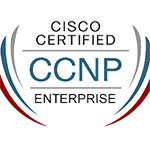ENARSI: Implementing Cisco Enterprise Advanced Routing and Services
Группа | Курс | Форма обучения | Период обучения | Дни недели | Время занятий |
|---|---|---|---|---|---|
| CCNP | |||||
| Интенсивное обучение | |||||
| CCNAv7 | |||||
- Описание курса
- Программа курса
 Данный курс позволяет подготовиться к сертификационному тесту 300-410 ENARSI, который является частью сертификации CCNP Enterprise. Курс поможет развить знания и навыки планирования, создания и мониторинга масштабируемых сетей Cisco. По сорержанию данный курс является продолжением курса ENCOR. CCNP - это дальнейшее карьерное продвижение для специалистов уровня CCNA.
Данный курс позволяет подготовиться к сертификационному тесту 300-410 ENARSI, который является частью сертификации CCNP Enterprise. Курс поможет развить знания и навыки планирования, создания и мониторинга масштабируемых сетей Cisco. По сорержанию данный курс является продолжением курса ENCOR. CCNP - это дальнейшее карьерное продвижение для специалистов уровня CCNA.Требования к слушателям: знание сетей на уровне CCNA. Желательно знание английского на уровне чтения технической документации.
Продолжительность обучения: 72 часа.
Документ об окончании: международный сертификат Академии Cisco о прохождении обучения.
Все пользователи получают регистрацию на учебном портале netacad.com
Chapter 1: IPv4/IPv6 Addressing and Routing Review
1.1. IPv4 Addressing
1.2. DHCP for IPv4
1.3. IPv6
1.4. Packet Forwarding
1.5. Troubleshoot IP addressing and host configuration
1.6. Troubleshoot static routes.Chapter 2: EIGRP
2.1. EIGRP Fundamentals
2.2. EIGRP Configuration
2.3. EIGRP MetricsChapter 3: Advanced EIGRP
3.1. EIGRP Failure Detection
3.2. EIGRP Route
3.3. Summarization
3.4. WAN Considerations
3.5. Route ManipulationChapter 4: Troubleshooting EIGRP for IPv4
4.1. Troubleshoot IPv4 Neighbor Adjacencies
4.2. Troubleshooting IPv4 Routes
4.3. Troubleshooting Miscellaneous EIGRP for IPv4 IssuesChapter 5: EIGRPv6
5.1. EIGRPv6 Fundamentals
5.2. Troubleshooting EIGRPv6 Neighbor Issues
5.3. Troubleshooting EIGRPv6 Routes
5.4. Troubleshooting Named EIGRPChapter 6: OSPF
6.1. OSPF Fundamentals
6.2. OSPF Configuration
6.3. The Designated Router and Backup Designated Router
6.4. OSPF Network Types
6.5. OSPF Failure Detection
6.6. OSPF AuthenticationChapter 7: Advanced OSPF 7.1. Link-State Advertisements
7.2. OSPF Stubby Areas
7.3. OSPF Path Selection
7.4. OSPF Route Summarization
7.5. Discontiguaus Networks and Virtual LinksChapter 8: Troubleshooting OSPFv2
8.1. Troubleshooting OSPFv2 Neighbor Adjacencies
8.2. Troubleshooting OSPFv2 Routes
8.3. Troubleshooting OSPFv2 IssuesChapter 9: OSPFv3
9.1. OSPFv3 Fundamentals
9.2. OSPFv3 Configuration
9.3. OSPFv3 LSA Flooding ScopeChapter 10: Troubleshooting OSPFv3
10.1. Troubleshooting OSPFv3 for IPv6
10.2. Troubleshooting OSPF v3 Address FamiliesChapter 11: BGP
11.1. BGP Fundamentals
11.2. Basic BGP Confiuration
11.3. BGP Session Types
11.4. Multiprotocol BGP for IPv6Chapter 12: Advanced BGP
12.1. Route Summarization
12.2. BGP Route Filtering and Manipulation
12.3. BGP Communities
12.4. BGP Prefixes and ScalabilityChapter 13: BGP Path Selection
13.1. Understanding BGP Path Selection
13.2. BGP Attributes
13.3. BGP Best Path
13.4. BGP Equal Cost MultipathChapter 14: Troubleshooting BGP
14.1. Troubleshooting BGP Neighbor Adjacencies
14.2. Troubleshooting BGP Routes
14.3. Troubleshooting BGP Path Selection
14.4. Troubleshooting BGP for IPv6Chapter 15: Route Maps and Conditional Forwarding
15.1. Conditional Matching
15.2. Route Maps
15.3. Conditional Forwarding of Packets
15.4. Conditional Forwarding TroubleshootingChapter 16: Route Redistribution
16.1. Redistribution Overview
16.2. Protocol Specific Redistribution ConfigurationChapter 17: Troubleshooting Redistribution
17.1. Troubleshooting Advanced Redistribution Issues
17.2. Troubleshooting IPv4 and IPv6 Redistribution
17.3. Troubleshooting Redistribution into OSPFChapter 18: VRF, MPLS, and MPLS Layer 3 VPNs
18.1. Implementing and Verifying VRF-Lite
18.2. MPLS Operations
18.3. MPLS Layer 3 VPNsChapter 19: DMVPN Tunnels
19.1. GRE Tunnels
19.2. Next Hop Resolution Protocol (NHRP)
19.3. Dynamic Multipoint VPN (DMVPN)
19.4. DMVPN Configuration and Operation
19.5. Spoke-to-Spoke Communication
19.6. Problems with Overlay Networks
19.7. DMVPN Failure Detection and High Availability
19.8. IPv6 DMVPN ConfigurationChapter 20: Securing DMVPN Tunnels
20.1. Elements of Secure Transport
20.2. IPsec Fundamentals
20.3. IPsec Tunnel ProtectionChapter 21: Troubleshooting ACLs and Prefix Lists
21.1. Troubleshooting IPv4 ACLs
21.2. Troubleshooting IPv6 ACLs
21.3. Troubleshooting Prefix ListsChapter 22: Infrastructure Security
22.1. Cisco AAA Troubleshooting
22.2. Troubleshooting Unicast Reverse Path Forwarding (uRPF)
22.3. Troubleshooting Control Plane Policing (CoPP)
22.4. IPv6 First-Hop SecurityChapter 23: Device Management and Management Tools Troubleshooting
23.1. Device Management Troubleshooting
23.2. Troubleshooting Tools

